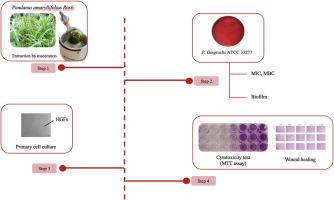Pandanus amaryllifolius ethanolic extract promotes oral gingival fibroblast healing and inhibits Porphyromonas gingivalis: An in-vitro study
Q1 Medicine
Journal of oral biology and craniofacial research
Pub Date : 2025-06-21
DOI:10.1016/j.jobcr.2025.06.015
引用次数: 0
Abstract
Introduction
This study aimed to evaluate the antimicrobial activity, cytotoxicity and cell migration of ethanolic extract of Pandanus amaryllifolius (PAE).
Methods
The antimicrobial activity of PAE was tested against Porphyromonas gingivalis (P. gingivalis) using the microdilution assay and determing minimum inhibitory and bactericidal concentration (MIC and MBC). Additionally, biofilm inhibition was assessed by crystal violet assay at different concentrations of PAE. Moreover, a 3-(4,5-dimethylthiazol-2-yl)-2,5-diphenyltetrazolium bromide (MTT) and scratch assays were performed to assess cell viability and migration of human gingival fibroblasts (HGFs).
Results
The MIC and MBC values of PAE against P. gingivalis were determined to be 16 mg/mL and 32 mg/mL, respectively. Significant biofilm inhibition was observed at concentrations of 8 mg/mL and 4 mg/mL. The MTT assay demonstrated that 4 mg/mL of PAE was non-toxic to HGFs, whereas higher concentrations exhibited cytotoxic effects. Furthermore, PAE at 4, 2, 1, and 0.5 mg/mL promoted wound healing in an in vitro model.
Conclusion
PAE exhibited cytotoxic effects on HGFs at concentrations above 4 mg/mL. However, lower concentrations promoted cell migration and demonstrated potential antimicrobial activity against P. gingivalis. These findings suggest that PAE may have applications in oral health for antimicrobial and wound-healing purposes.

香兜草乙醇提取物促进口腔牙龈成纤维细胞愈合和抑制牙龈卟啉单胞菌:一项体外研究
本研究旨在研究香豆醇提物(PAE)的抑菌活性、细胞毒性和细胞迁移性。方法采用微量稀释法测定PAE对牙龈卟啉单胞菌(P. gingivalis)的抑菌活性,并测定最低抑菌浓度(MIC)和最低杀菌浓度(MBC)。此外,采用结晶紫法评价不同浓度PAE对生物膜的抑制作用。此外,采用3-(4,5-二甲基噻唑-2-基)-2,5-二苯基溴化四唑(MTT)和划痕法评估人牙龈成纤维细胞(HGFs)的细胞活力和迁移能力。结果PAE对牙龈假单胞菌的MIC值为16 mg/mL, MBC值为32 mg/mL。8 mg/mL和4 mg/mL浓度对生物膜有明显的抑制作用。MTT实验表明,4 mg/mL PAE对hgf无毒,而更高浓度的PAE则表现出细胞毒作用。此外,4、2、1和0.5 mg/mL的PAE在体外模型中促进伤口愈合。结论pae浓度在4 mg/mL以上时对HGFs具有细胞毒作用。然而,较低的浓度促进细胞迁移,并显示出对牙龈假单胞菌的潜在抗菌活性。这些发现表明PAE可能在口腔健康中具有抗菌和伤口愈合的目的。
本文章由计算机程序翻译,如有差异,请以英文原文为准。
求助全文
约1分钟内获得全文
求助全文
来源期刊

Journal of oral biology and craniofacial research
Medicine-Otorhinolaryngology
CiteScore
4.90
自引率
0.00%
发文量
133
审稿时长
167 days
期刊介绍:
Journal of Oral Biology and Craniofacial Research (JOBCR)is the official journal of the Craniofacial Research Foundation (CRF). The journal aims to provide a common platform for both clinical and translational research and to promote interdisciplinary sciences in craniofacial region. JOBCR publishes content that includes diseases, injuries and defects in the head, neck, face, jaws and the hard and soft tissues of the mouth and jaws and face region; diagnosis and medical management of diseases specific to the orofacial tissues and of oral manifestations of systemic diseases; studies on identifying populations at risk of oral disease or in need of specific care, and comparing regional, environmental, social, and access similarities and differences in dental care between populations; diseases of the mouth and related structures like salivary glands, temporomandibular joints, facial muscles and perioral skin; biomedical engineering, tissue engineering and stem cells. The journal publishes reviews, commentaries, peer-reviewed original research articles, short communication, and case reports.
 求助内容:
求助内容: 应助结果提醒方式:
应助结果提醒方式:


